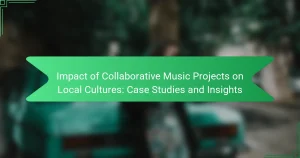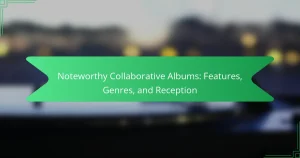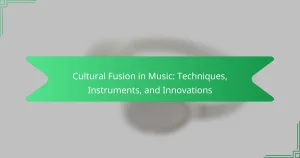Technology enhances collaborative music projects by improving communication and streamlining workflows. Key platforms like Soundtrap and BandLab facilitate real-time collaboration and file sharing. Emerging trends such as AI-driven composition and virtual reality environments offer innovative creative possibilities. However, challenges like communication barriers and technical difficulties can impact the collaboration process.
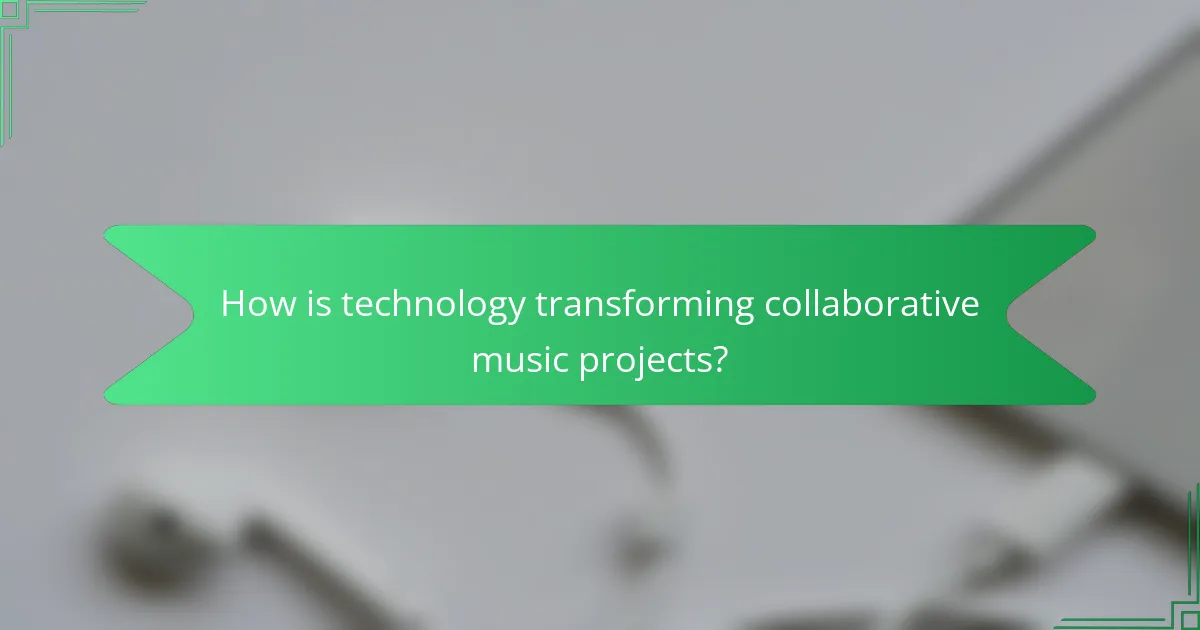
How is technology transforming collaborative music projects?
Technology is revolutionising collaborative music projects by enhancing communication, streamlining workflows, and providing innovative tools. Digital audio workstations enable real-time collaboration across distances, allowing musicians to create together seamlessly. Cloud-based platforms facilitate file sharing and project management, making it easier to coordinate efforts. Emerging trends like artificial intelligence assist in music composition, offering new creative possibilities. These advancements foster a more inclusive and diverse music-making environment.
What are the key tools driving collaboration in music creation?
Key tools driving collaboration in music creation include digital audio workstations, cloud-based platforms, and communication apps. These technologies enhance remote teamwork and streamline the creative process.
Digital audio workstations (DAWs), such as Ableton Live and Pro Tools, provide essential features for recording, editing, and mixing music collaboratively. Cloud-based platforms like Splice enable seamless sharing of projects and samples, allowing artists to work together from different locations. Communication apps, such as Slack and Zoom, facilitate real-time discussions and feedback, fostering a collaborative environment.
Emerging trends include the integration of artificial intelligence in music production, which offers innovative tools for collaboration and creativity. These advancements enable musicians to explore new sounds and techniques, enhancing their collaborative efforts.
Which platforms are most popular for collaborative music projects in 2025?
In 2025, popular platforms for collaborative music projects include Splice, Soundtrap, BandLab, and Audiomack. These platforms offer unique tools for musicians to create, share, and collaborate remotely. Splice excels with its extensive sample library, while Soundtrap provides an intuitive online studio experience. BandLab integrates social networking features, facilitating community collaboration. Audiomack focuses on music distribution and promotion, enhancing visibility for collaborative projects.
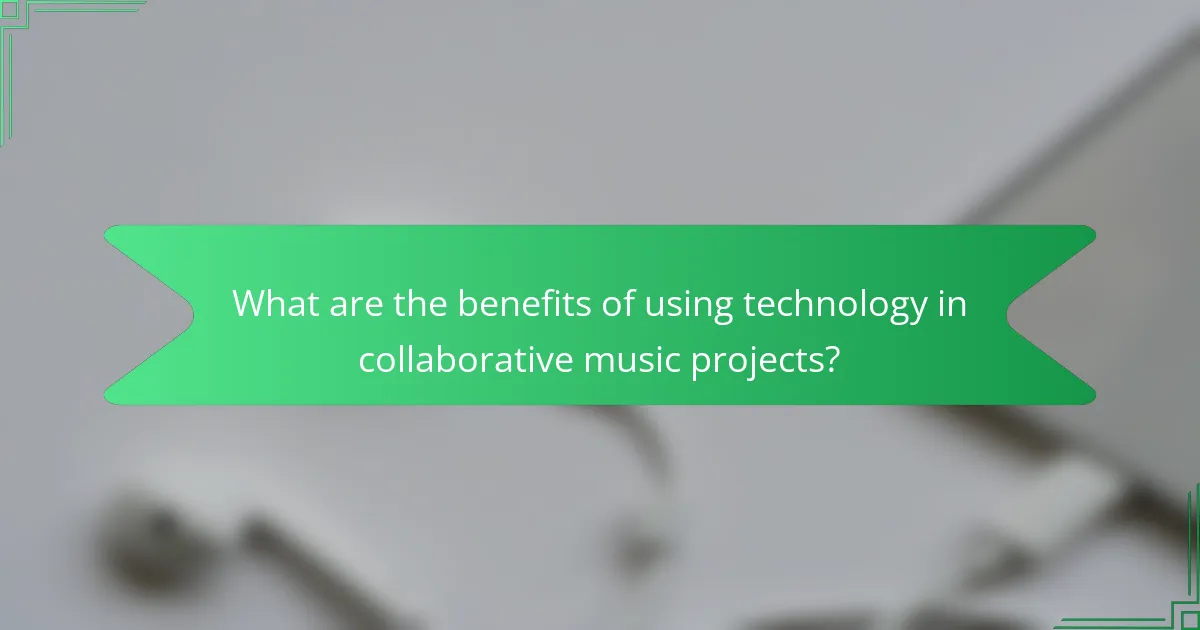
What are the benefits of using technology in collaborative music projects?
Using technology in collaborative music projects enhances creativity, streamlines communication, and increases accessibility. It allows musicians to collaborate in real-time, regardless of location, fostering innovation. Platforms like Soundtrap and BandLab enable seamless sharing of ideas and files, while tools such as digital audio workstations (DAWs) facilitate high-quality production. Additionally, cloud storage solutions ensure that all collaborators have access to the latest versions of their work, minimising confusion and enhancing efficiency. These technological advancements empower musicians to push creative boundaries and explore new genres together.
How does technology enhance creativity and innovation in music collaboration?
Technology significantly enhances creativity and innovation in music collaboration by providing diverse tools and platforms. These innovations allow artists to connect globally, share ideas, and experiment with sounds in real-time. Collaborative software, such as digital audio workstations and cloud-based platforms, enable seamless communication and co-creation, breaking geographical barriers. Emerging trends like artificial intelligence and virtual reality further expand creative possibilities, allowing for unique musical experiences. As a result, technology not only streamlines the collaborative process but also fosters a more inclusive and dynamic music-making environment.
What role does technology play in accessibility for musicians?
Technology enhances accessibility for musicians by providing innovative tools that facilitate collaboration. Digital audio workstations, cloud-based platforms, and mobile applications enable remote teamwork and streamline the creative process. These advancements allow musicians to connect regardless of location, fostering inclusivity and diverse contributions. Emerging trends include virtual reality jam sessions and AI-assisted composition, which further expand collaborative possibilities.
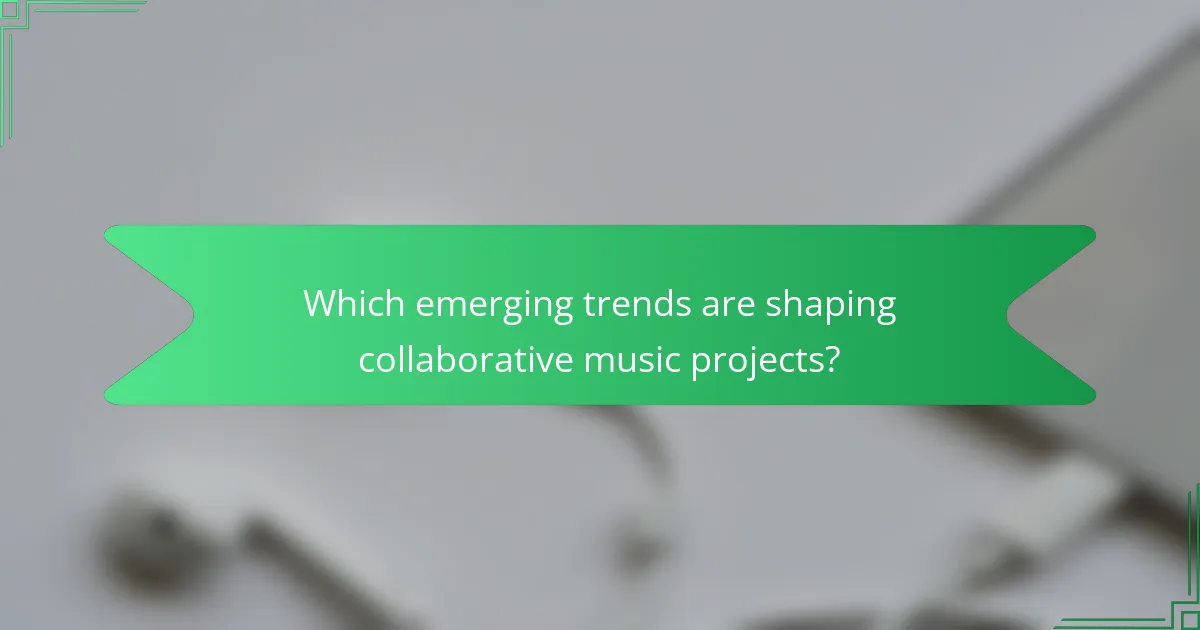
Which emerging trends are shaping collaborative music projects?
Emerging trends in collaborative music projects are heavily influenced by technology. Key trends include cloud-based collaboration tools, AI-driven composition, and virtual reality environments. These innovations enhance creativity and streamline the production process. For example, platforms like Splice and Soundtrap enable real-time collaboration across distances. Additionally, AI tools assist in music creation, offering unique sound suggestions and arrangements. Virtual reality provides immersive experiences for artists to collaborate in shared digital spaces, fostering innovation and connection.
What is the impact of artificial intelligence on music collaboration?
Artificial intelligence significantly enhances music collaboration by streamlining creative processes and enabling innovative soundscapes. AI tools analyse vast datasets, suggesting chord progressions and melodies that inspire artists. Platforms like Amper Music and AIVA allow musicians to co-create with algorithms, transforming traditional workflows. As a result, collaboration transcends geographical boundaries, fostering diverse musical styles and ideas. This technological integration not only democratises music creation but also enriches the artistic landscape, encouraging experimentation and unique compositions.
How are virtual reality and augmented reality influencing collaborative music experiences?
Virtual reality and augmented reality are transforming collaborative music experiences by enhancing interaction and creativity. These technologies allow musicians to collaborate in immersive environments, regardless of geographical barriers.
Virtual reality enables users to create and manipulate soundscapes in 3D spaces, fostering innovative compositions. Augmented reality overlays digital elements onto the real world, making live performances more engaging.
For instance, platforms like Oculus Venues and Spatial.io facilitate virtual jam sessions, where artists can share ideas in real-time. These tools enhance the creative process, making collaboration more dynamic and accessible.
As a result, virtual and augmented reality are not just tools but essential elements in modern collaborative music projects, shaping new trends in the industry.
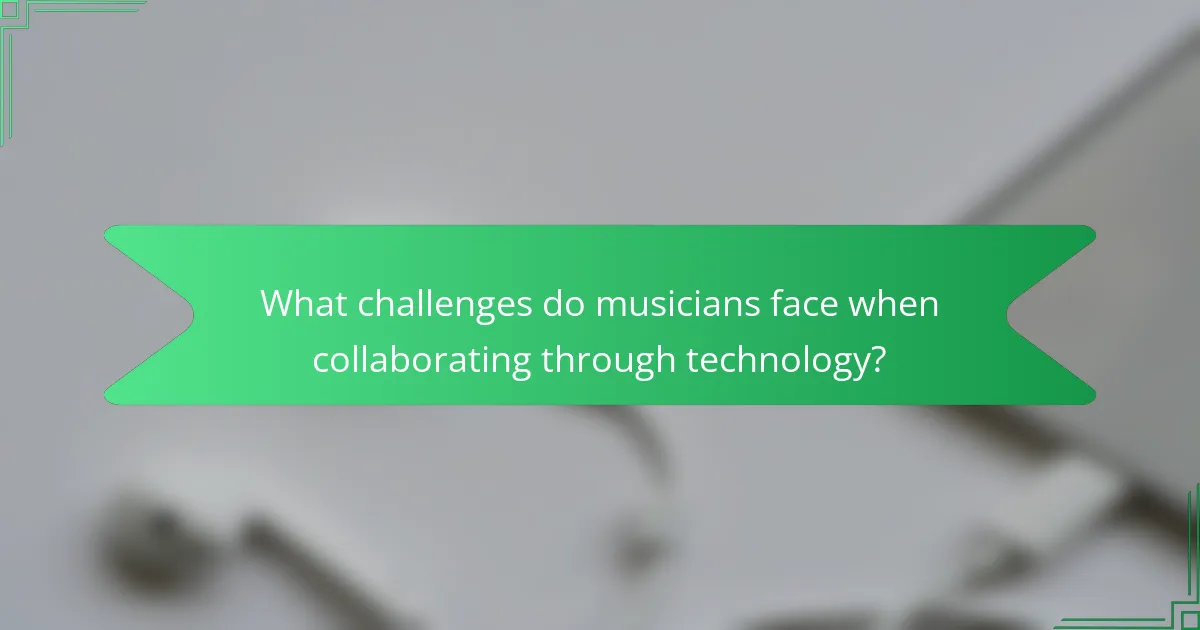
What challenges do musicians face when collaborating through technology?
Musicians face several challenges when collaborating through technology, including communication barriers and technical difficulties. These issues can hinder creativity and workflow.
First, varied time zones complicate real-time collaboration. Musicians may struggle to synchronise their schedules, leading to delays in project progress.
Second, differing levels of technical proficiency can create frustration. Not all collaborators may be familiar with the same tools or platforms, impacting the quality of the output.
Third, reliance on technology can lead to a lack of personal connection. The absence of face-to-face interaction may affect trust and rapport among musicians.
Finally, software compatibility issues can arise. Different platforms may not support the same file formats, complicating the sharing of ideas and materials.
How do technical issues affect the collaborative process?
Technical issues can significantly disrupt the collaborative process in music projects. They can lead to communication breakdowns, delayed timelines, and hindered creative flow. Common technical challenges include software compatibility, internet connectivity, and hardware malfunctions. These issues can create frustration among team members, affecting overall productivity and collaboration quality. Addressing these challenges through reliable tools and platforms is essential for smooth collaboration.
What are the common misconceptions about technology in music collaboration?
Many misconceptions about technology in music collaboration suggest it replaces human creativity. In reality, technology enhances collaboration by facilitating communication and providing tools for creativity. Another misconception is that technology is only for professionals; however, numerous platforms cater to all skill levels, enabling anyone to collaborate. Additionally, some believe that technology complicates the process, while it often streamlines workflows and improves efficiency. Finally, there is a notion that technology limits musical genres, yet it actually broadens access to diverse styles and influences.
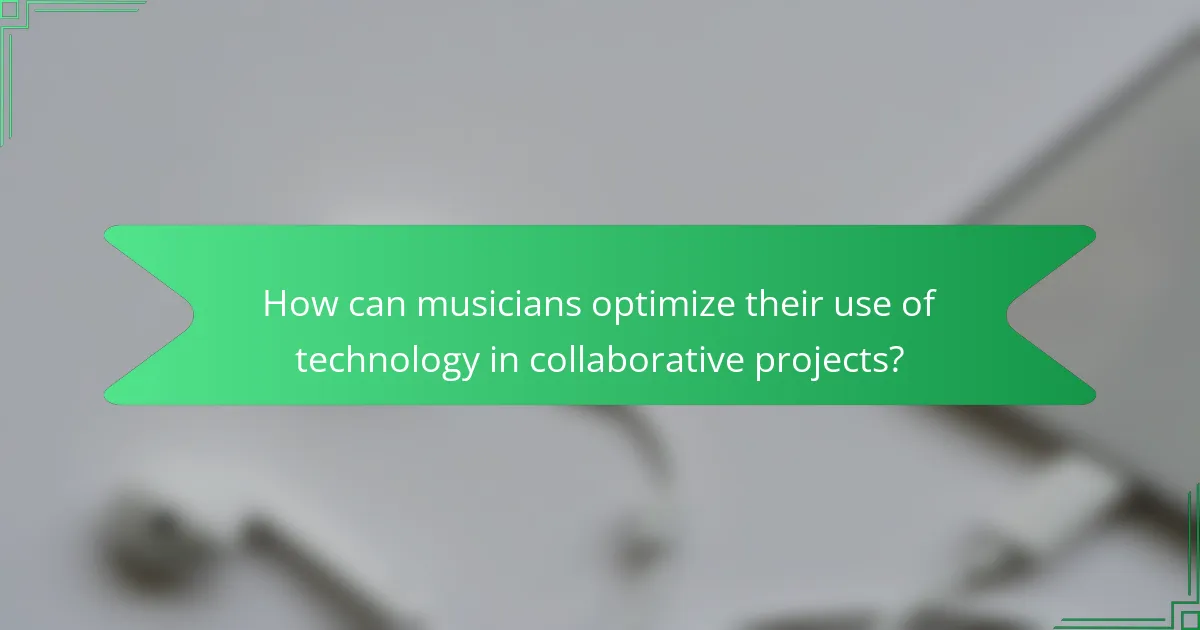
How can musicians optimize their use of technology in collaborative projects?
Musicians can optimise technology use in collaborative projects by selecting appropriate tools and platforms that enhance communication and creativity. Utilising cloud-based software allows for real-time collaboration, while digital audio workstations facilitate seamless music production.
1. Choose collaboration tools like Splice or Soundtrap for easy file sharing.
2. Use project management apps like Trello or Asana to organise tasks and deadlines.
3. Implement communication platforms such as Zoom or Slack for effective discussions.
4. Explore social media for networking and promoting collaborative works.
5. Leverage AI-driven tools for music composition and arrangement assistance.
These strategies improve workflow, enhance creativity, and foster stronger partnerships among musicians.
What best practices should musicians follow when using collaborative tools?
Musicians should prioritise clear communication, establish shared goals, and choose suitable collaborative tools. Effective collaboration enhances creativity and productivity in music projects.
1. Define roles and responsibilities to avoid confusion.
2. Use cloud-based platforms for real-time collaboration.
3. Regularly update all team members on project progress.
4. Schedule consistent check-ins to maintain alignment.
5. Encourage open feedback to foster innovation.
Which mistakes should musicians avoid in technology-driven collaborations?
Musicians should avoid poor communication, lack of planning, over-reliance on technology, and ignoring feedback. Effective collaboration requires clear roles and responsibilities. Establishing a structured workflow enhances creativity and productivity. Balancing technology with personal interaction is crucial for successful outcomes.
